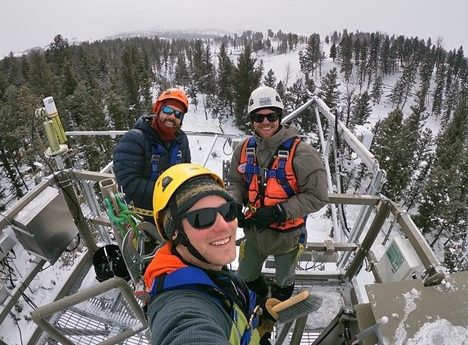Image: The view from NEON’s field site in Yellowstone National Park. Photo courtesy of Battelle, NEON Program.
Meet Our New Partner: National Ecological Observatory Network (NEON)
Thriving Earth Exchange and NEON join forces to bring powerful ecological data to bear on community priorities
 When we think of challenges like sea level rise or air pollution, the first thing that springs to mind is often the physical environment—beaches eroding away or harmful particles floating through the air. But living environments, the ecosystems we dwell within and depend upon, have an equally large impact on our lives and our communities.
When we think of challenges like sea level rise or air pollution, the first thing that springs to mind is often the physical environment—beaches eroding away or harmful particles floating through the air. But living environments, the ecosystems we dwell within and depend upon, have an equally large impact on our lives and our communities.
With a new partnership, Thriving Earth Exchange is expanding communities’ ability to tap into rich ecological data as they work to address pressing concerns where people and ecosystems meet.
The National Science Foundation’s National Ecological Observatory Network (NEON) collects long-term open access ecological data focused on understanding how U.S. ecosystems are changing at local, regional, and continental scales. Through the new partnership, NEON and Thriving Earth Exchange will work to equip communities with ecological data relevant to the challenges they are tackling while also forging new connections between communities and scientists in both organizations’ networks.
“We decided to partner with Thriving Earth Exchange to better connect our data to the needs and priorities of communities across the United States,” said NEON Chief Scientist and Observatory Director Paula Mabee. “We believe Thriving Earth Exchange will be a valuable partner in helping NEON foster partnerships between local communities and scientists using our data to produce on-the-ground science impact.”
NEON, operated by Battelle, includes 81 field sites across the United States that gather and manage high-quality data on interactions between land, life, and water. The Observatory became fully operational in 2019 after two decades of planning and construction. Partnering with Thriving Earth Exchange, which has facilitated collaborations among communities and scientists since its launch in 2013, offers an opportunity to expand the reach of NEON data and expertise beyond the scientific realm to benefit local communities directly.
“Thriving Earth Exchange and NEON complement each other perfectly,” said Mabee. “The connections between scientists and community leaders that can be built and nurtured through Thriving Earth Exchange will enable NEON’s reach and engagement to grow. In turn, we will be able to work with more networks of scientists and foster communities’ ability to use NEON data to implement solutions to local challenges.”
Partnerships are key to Thriving Earth Exchange’s process of matching community priorities with the information and expertise that will be most useful to inform decisions and drive action. By joining forces, the organizations hope to help get usable, actionable ecological information into the hands of local communities who need it to make headway in addressing problems like climate adaptation and the preservation of natural resources.
This exchange is envisioned as a two-way street between communities and scientists. “We want these communities to be active stakeholders in guiding and contributing to the use of NEON resources,” said Mabee.
As a first step, the two organizations will select 12 fellows from NEON field science staff and help them connect to local communities near NEON field offices throughout the United States. By supporting the Fellows with training and capacity building, but not direct management by Thriving Earth Exchange specialists, the partnership will represent an exciting new model for implementing the community science model far and wide.
“This partnership is a triple play,” said Thriving Earth Exchange Director Raj Pandya. “We’ll be able to launch new projects in new places, we’ll make it easier for community groups to connect with and use NEON’s science and data, and we’ll find new ways for large-scale research and infrastructure projects to incorporate community science approaches. “


2 Comments
sharon pfeiferDec 22, 2020 at 9:30 AM
My doctorate is in behavioral and population ecology with a postdoctorate in conservation biology done at the Smithsonian’s Conservation and Research Center (now renamed). I have spent a decade teaching global ecology, landscape ecology, and conservation ecology and 3 decades doing biodiversity, green infrastructure, and groundwater protection work with local governments. Is there a way I can fit into NEON’s efforts as a current TEX Fellow?
Robert O’BrienJan 2, 2021 at 11:54 AM
Dear Sharon, would you be interested in a project in Jamaica
With Jamaica Conversation Partners.